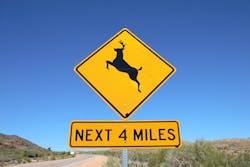The likelihood of colliding with a deer more than doubles during the months of October, November and December. That is when deer are most active, because it is their migration and mating season.
As such, there is a substantial increase in the movement of the deer population. That puts more deer in roadways than at any other time of year.
Consequently, more deer-vehicle collisions (DVCs) occur within this three-month period than at any other time of year.
Collisions can be Costly
Whether a vehicle hits a deer or it jumps into the side of a vehicle, such collisions can cause significant injuries and property damage.
The Insurance Institute for Highway Safety (IIHS) estimates there are some 1.5 million DVCs annually in the U.S., causing more than 150 vehicle occupant fatalities, tens of thousands of injuries and more than $1 billion in vehicle damage.
IIHS (www.iihs.org) is an independent, nonprofit scientific and educational organization dedicated to reducing the losses – deaths, injuries and property damage – from motor vehicle crashes.
There are also the costs from unscheduled vehicle downtime, unplanned vehicle repair and the loss of fleet and shop productivity.
Safety Measures
Most deer-vehicle accidents occur during the night, or anytime between dusk and dawn. That is because deer are nocturnal animals and spend most of their time foraging during these periods.
While not all deer-vehicle collisions can be prevented, safety officials say there are steps that drivers can take to help avoid them. Be sure to disseminate this information to your staff, drivers and all other employees to help them avoid a DVC.
The most effective way to avoid deer-vehicle collisions is through attentive driving behavior, the officials point out, and note that driver reaction usually dictates the severity of such accidents.
Best Practices
Safety officials offer this additional advice to help keep drivers safe and minimize the chances of colliding with a deer when driving:
- Heed deer crossing signs. Decrease vehicle speed in these areas and drive with extra caution. The sooner a deer is seen on or approaching a roadway, the better the chance of avoiding a crash.
- Be especially watchful in areas near woods, farmlands, water and areas known to have a large deer population. When driving through these areas, keep eyes moving and continually glance to both sides of the road.
- Do not rely on devices such as deer whistles, deer fences and reflectors to deter deer as these devices have not proven effective.
- At night, use high-beam headlights because they better illuminate the edges of the road where deer may linger. Look for the reflection of light in a deer’s eyes. If you see eyes reflected in your headlights, slow down immediately.
- Headlights tend to hypnotize deer when a vehicle approaches. If a deer is spotted, be alert, slow down quickly and sound the horn to try and scare it away.
- Be prepared to safely stop if necessary.
- If deer are near the road, use the emergency flashers to alert other drivers of their presence.
- Keep in mind that if one deer is spotted, more are usually nearby. Deer often travel in groups and in a single file line.
- Deer are unpredictable in their movements, especially when confronted with glaring headlights, blaring horns and moving vehicles. Be prepared for the unexpected.
- Do not assume to know how a deer will react. Deer may dart suddenly in front of you, stop in the middle of the road, double back to the side of the road where they came from or rush across to the other side of the road.
- If a collision with a deer seems inevitable, brake firmly and attempt to stop. Do not swerve to avoid the deer as vehicle control may be lost, increasing the risk of injury due to hitting another vehicle or a fixed object like a tree.
- If a deer is struck, stay away from it. It may just be stunned and could become very aggressive if aroused. A frightened and wounded deer can hurt you or further injure itself. Report the accident to local law enforcement or to the Game Commission.
About the Author

